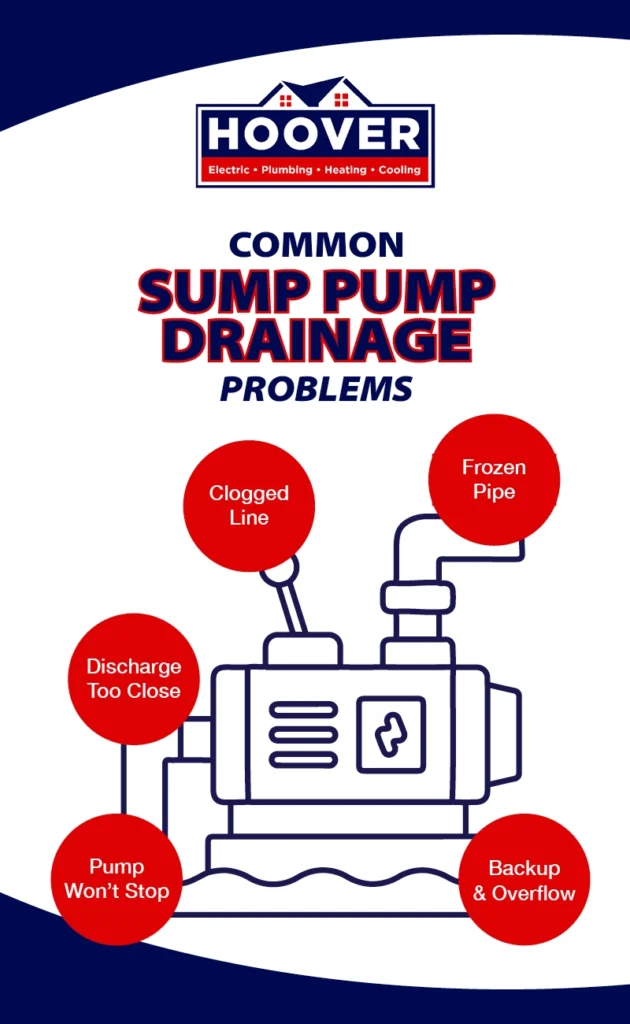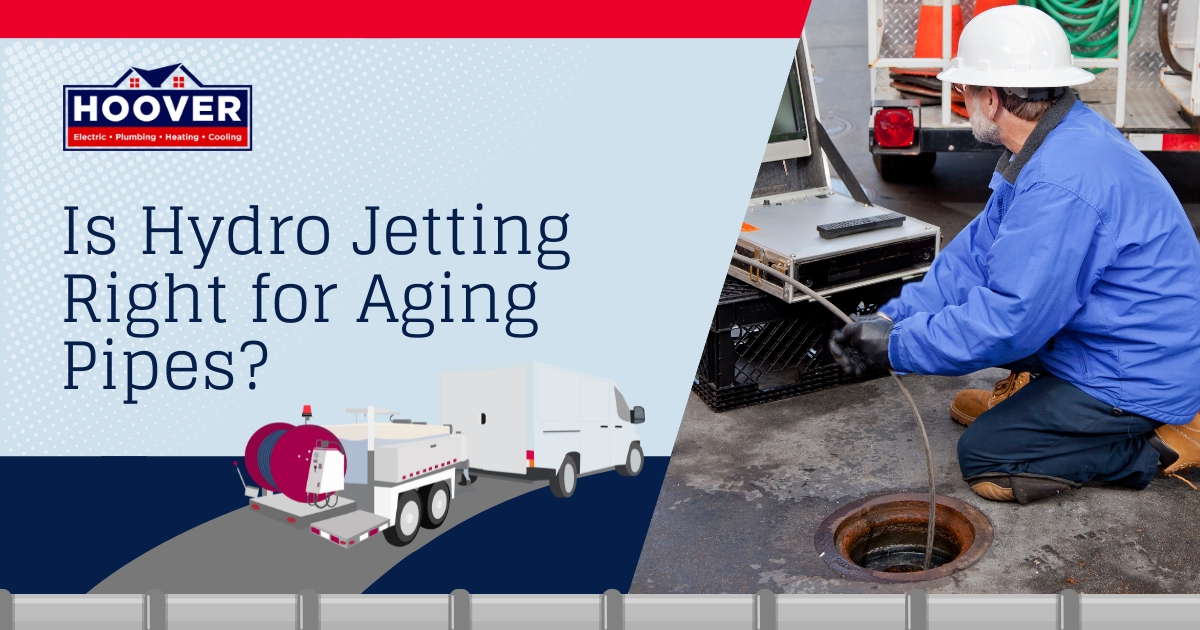
If you live in the city of Detroit, MI, or the surrounding areas, your home may have a basement with a sump pump. A sump pump discharges excess water from the lowest point in your house, typically the basement, but it’s only effective if it drains properly. If the pump doesn’t drain properly, it could cause flooding and damage your home.
The team at Hoover Electric, Plumbing, Heating, and Cooling has information about common sump pump drainage problems, how to prevent them, maintenance and troubleshooting tips, and best practices to help you avoid serious water damage and expensive repairs.
Common Sump Pump Drainage Problems
Here are some of the most common sump pump problems that Detroit area homeowners face.

Improper discharge placement
The discharge (water) coming from your sump pump should be directed away from the house for proper drainage. Improper placement can cause foundation damage, soil erosion, water pooling, and flooding. A safe distance for sump pump discharge is a minimum of 10 feet away from your home — ideally, 20 feet.
Clogged discharge lines
Debris, leaves, and dirt can block the sump pump discharge line, causing a clog. Gurgling noises, slow or no water draining from the sump pump, a sewage smell, and water pooling around the sump pump are signs of a clog. To clear a clog, turn off the sump pump and look for blockages, then remove them by hand or with a plumbing drain snake. If the pump is still clogged, call the Hoover team to locate and remove it.
Frozen sump pump discharge pipe
Winter temperatures may freeze your sump pump drainage lines, creating an icy blockage and causing pump failure and basement flooding. Bury the pipe or discharge line five feet below the frost line or use foam insulation to prevent the discharge pipes from freezing.
The sump pump runs continuously without draining
A sump pump that runs continuously without draining may have issues with its components or the drainage system. This may be due to a faulty float switch, a clogged discharge pipe, or a broken check valve. High water tables, check valve issues, and improper drainage placement all affect your sump pump’s performance.
Sump pump backups & overflows
If your sump pump is backed up, it may overflow and cause flooding. Aging or damaged pipes, frozen lines, sump pump malfunctions, and clogs can cause this issue. To prevent overflows during heavy rain or storms, inspect your sump pump and remove clogs, check the float switch and discharge lines, and keep it properly maintained all year round.
Best Practices for Proper Sump Pump Drainage
Consider these best practices for proper sump pump discharge solutions and basement flooding prevention:
- Check discharge line installation: Verify that the discharge line is placed correctly to prevent water from coming back into the sump pit. Your discharge line should be buried at least one to five feet below the frost line.
- Prevent clogs: Install a grated cover over your sump pump discharge line to catch debris. Flush the discharge pipe periodically to remove blockages and prevent clogs.
- Protect from freezing: Adding foam insulation to your discharge pipes keeps them protected from freezing temperatures. Place the line on a downward slope or use freeze-resistant pipe extensions. Consider installing a freeze guard or adding heat tape to the discharge pipe as an alternative if you live in a cold climate.
- Ensure proper water flow: Keep the water flowing away from your house with the right grading and landscape drainage. Install French drains or dry wells for better water disposal, and use permeable materials to keep water from pooling near your home.
Routine Maintenance to Prevent Sump Pump Drainage Issues
Part of knowing how to prevent sump pump issues includes performing routine maintenance to keep the drainage flowing. Here are some maintenance tips to keep your sump pump draining properly.
Inspect and clean the sump pump regularly
Inspect and clean your sump pump and drainage lines at least every three to four months. During the winter, monthly inspections are recommended to look for freezing or clogs from leaves. Look for signs of wear and tear on pipes, check valves, and float switches, such as air and water leaks, rust or corrosion, and erratic pump operation (short cycling).
Test your sump pump before storms
Before a storm, manually test your sump pump by lifting the float switch to simulate water accumulation. Confirm the pump turns on and discharges water through the pipe, and look for signs of malfunction, like water backing up. Confirm that your battery or generator is working as a backup power source.
Inspect the check valve
A broken check valve allows water to flow back into the sump pit when the pump turns off. Turn off the water supply and power to the sump pump, remove the old check valve, and replace it with a new one, or contact Hoover for help.
Emergency Fixes for Sump Pump Drainage Failures
If your sump pump drainage fails, try these emergency fixes until you can schedule Hoover to come out for service and repairs.
- Sump pump stops draining: Make sure your sump pump is properly connected and powered on. Next, visually inspect the drain line to look for kinks or clogs and remove the clog if one is present. Turn the water and power supply off before you remove the blockages.
- Frozen discharge line: Use a hair dryer or heat gun to slowly thaw the pipe. You can also wrap the line in a blanket or pour hot (not boiling) water down the pipe to melt excess ice. Another short-term solution may be to reroute water toward your yard or into the laundry or tub main house drain until a fix is in place.
- Sump pump overflows or backs up: If you’ve tried to troubleshoot and fix an overflowing or backed-up sump pump with no luck, contact a licensed plumber for help. The knowledgeable team at Hoover is available to troubleshoot and repair all types of sump pump issues.
Choosing the Right Backup System for Sump Pump Drainage
Choosing and using the right backup system for your sump pump is important for proper drainage and to prevent flooding. This backup system turns on when you lose power to the sump pump to keep it running.
Battery backup vs. water-powered backup pumps
A battery-powered backup pump is easy to install and operates independently of your home’s water supply. However, this option has a limited runtime during power outages, and you’ll need to purchase replacement batteries periodically.
A water-powered backup pump requires a municipal water connection because it uses your home’s water supply to provide continuous operation. This backup system has an unlimited runtime with no batteries required, but it may result in higher water bills.
Adding an overflow alarm for early detection
A sump pump alarm alerts you when your basement or crawlspace starts to flood. This alarm allows for early detection so you can address the issue before things get worse. Choose a Wi-Fi-connected alarm system so you receive instant alerts for leaks, high water, and system issues at any time.
Keep Your Sump Pump Drainage System in Top Shape With Hoover
The trained professionals at Hoover Electric, Plumbing, Heating, and Cooling install and repair basement, submersible, and backup battery-operated sump pumps in and around Detroit and Troy, MI. We’ll help you troubleshoot, locate, diagnose, and repair a variety of sump pump issues to protect your home. If you want to learn more or would like to schedule a service, contact us today!


